‘By a Flash and a Scare’ by John E. Archer
£8.18
‘By a Flash and a Scare’ Arson, Animal Maiming, and Poaching in East Anglia 1815-1870 by John E. Archer
In stock
Description
ing riots, Tolpuddle, and the New Poor Law riots have long attracted the attention of historians, but here John E. Archer focuses on the persistent war waged in the countryside during the 1800s, analysing the prevailing climate of unrest, discontent, and desperation.
In this detailed and scholarly study, based on intensive research among the local records of Norfolk and Suffolk, Dr Archer identifies and examines the three most serious crimes of protest in the countryside — arson, animal maiming and poaching. He shows how rural society in East Anglia was shaped by terror and oppression in equal measure. Social crime and covert protest were an integral part of the ordinary life of the rural poor. They did not protest infrequently, they protested all the time.
Incendiary attacks were repeatedly the meeting points for large displays of collective protest and celebration, were expressions of grievance, and marked a stage in the development of the rural war. Animal maiming was a retrospective individualistic response to some personal harm and was intended to show that the powerless were indeed capable of striking back. The majority of country people never accepted the game laws. No armies of keepers, no statute book of laws, no mantraps, and certainly no titled gentleman, could dissuade them from their belief that poaching was not a crime. These actions, along with anonymous and threatening letters, were the constant reminders and realities for the landed classes to remain on their guard.
‘By a Flash and a Scare’ dispels any lingering notions of a ‘green and pleasant land’, and makes an important contribution to our understanding of life in the nineteenth century countryside.
John E. Archer is an honorary research fellow at Edge Hill University. He has published widely on 19th century protest and crime. He is currently working on the history of violence in the north west of England.
K.D.M. Snell, Times Higher Education Supplement
“The extent of Archer’s analysis is breath-taking; we learn in detail where, when and how arson occurred. He is a persuasive historian, and,…has an eye for the simple as well as complex explanation.”
David J.V. Jones, T.L.S.
“Archer dispels any nominal notion of rural bliss and proletarian acquiescence in Norfolk and Suffolk.”
Roger Wells
ABBREVIATIONS
Preface
- 1. An Introduction to Rural Protest
- The Categorization of Rural Crime
- Crime in the Countryside
- 2. The Farm Labourer: Work and Wages
- 3. The Labouring Community and the Relief of Poverty: ‘A Class Which Has Something to Lose’
- 4. Incendiarism: Annual Survey 1815-1834
- Introduction
- Incendiarism: A New Expression of Grievance
- Annual Summary — 1815-1819
- The 1820s
- The Swing Years 1830-1833
- 5. Incendiarism: Annual Survey 1835-1870
- 1835-1841: The Introduction of the New Poor Law
- The 1840s
- The Mid-century Depression 1849-1852
- The Era of High Farming 1853-1870
- 6. Incendiarism: An Analysis
- The Location and Timing of Incendiary Attacks
- Prices, Wages, and Unemployment
- Mechanization and Incendiarism
- Incendiarism and the Poor Laws
- Incendiarism and Rural Crime
- Victims of Incendiarism
- Protection and Detection
- Why Incendiarism?
- 7. The Myth and Reality of the Incendiary
- Introduction
- The Myth
- The Reality
- 8. Animal Maiming: ‘A Fiendish Outrage’?
- 9. The Poaching War: ‘The Great Attraction’
- Introduction
- The Poacher
- Policing and Detection
- Protest and Poaching
- 10. Conclusion





